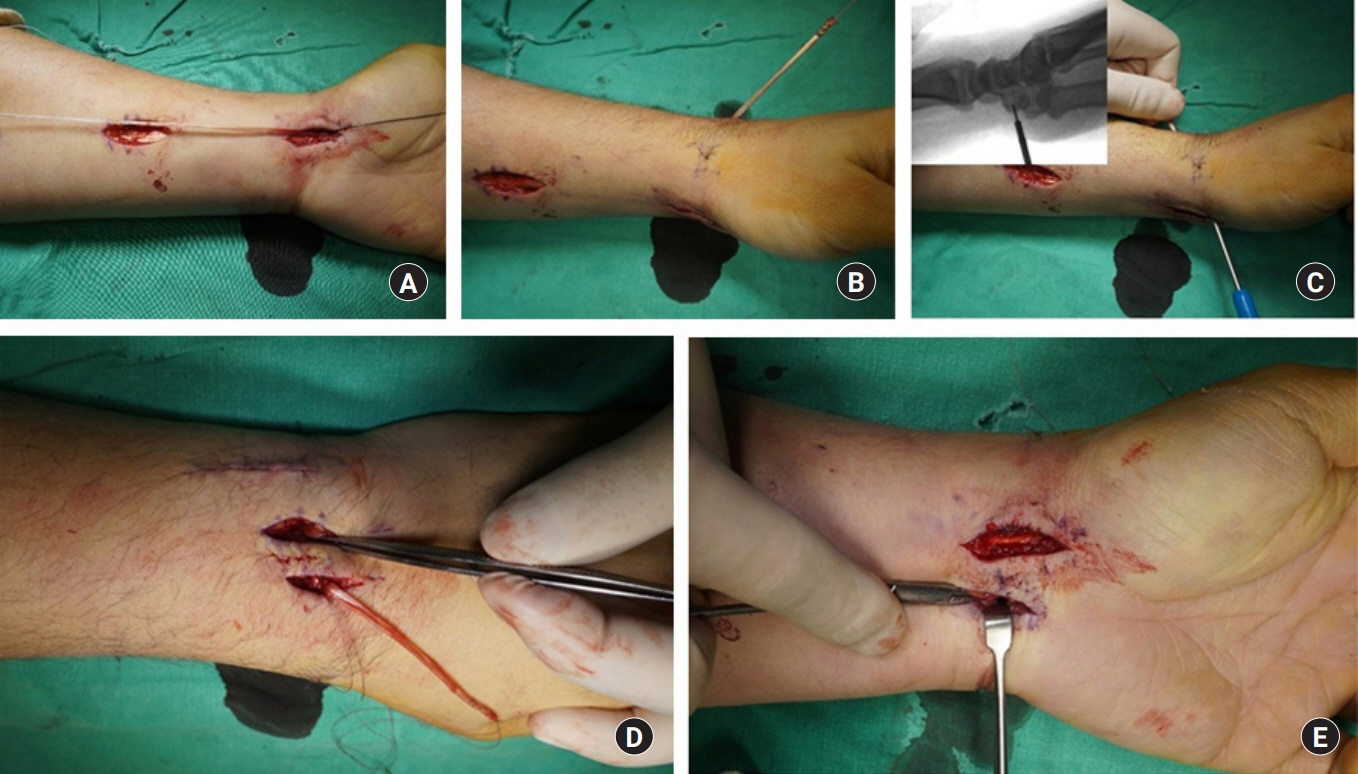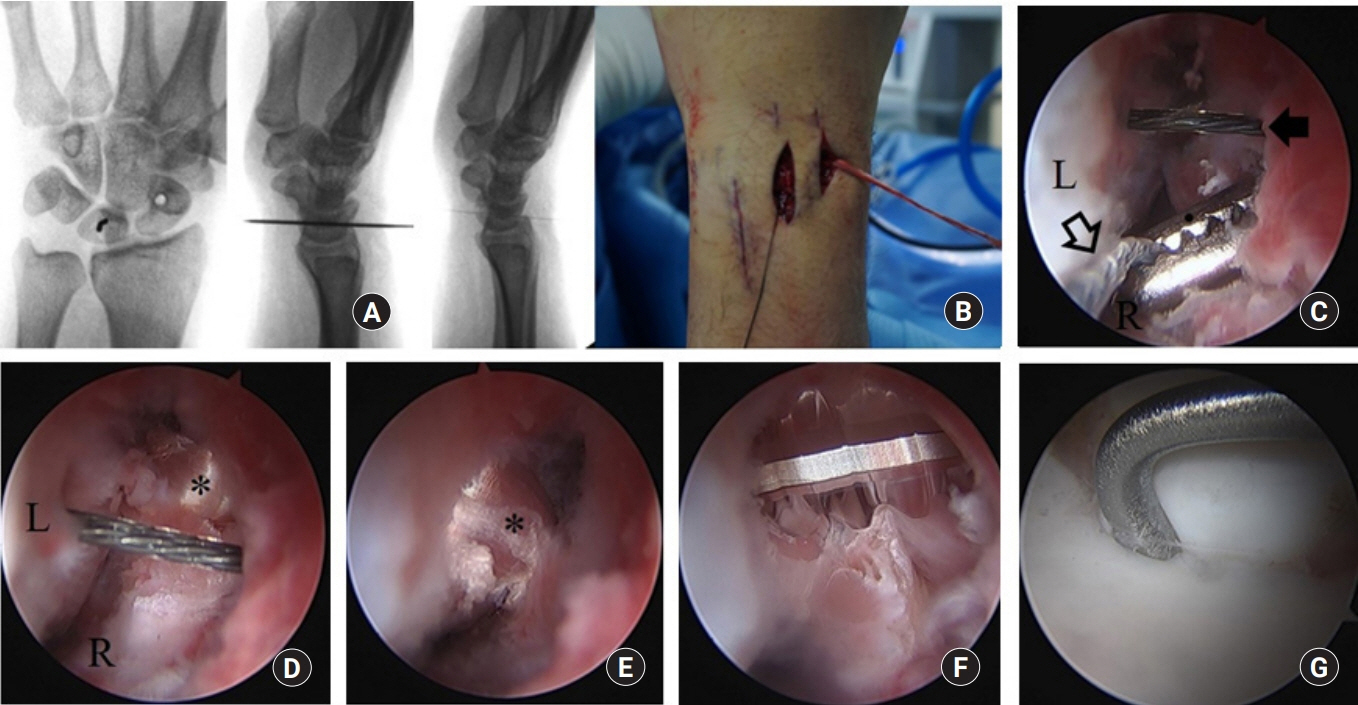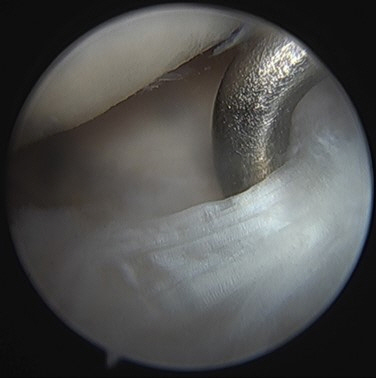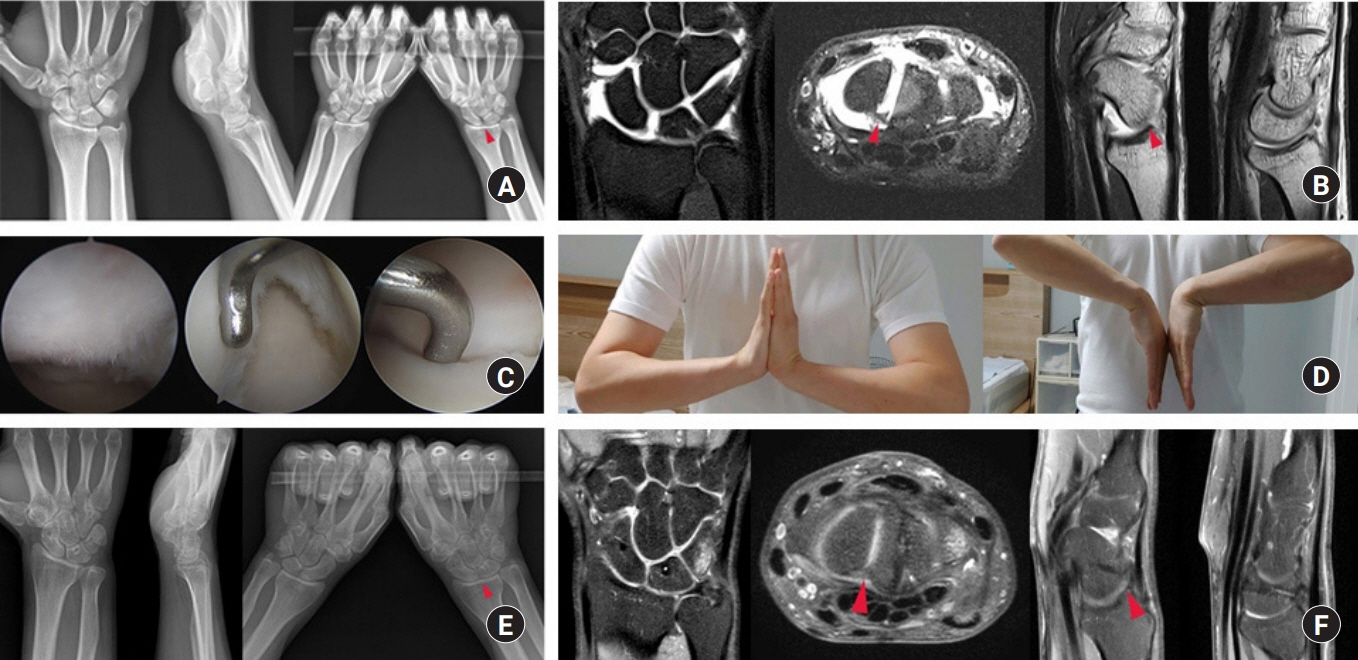Arch Hand Microsurg.
2020 Jun;25(2):108-117. 10.12790/ahm.20.0012.
Results of Arthroscopically Assisted Volar and Dorsal Scapholunate Ligament Reconstruction Using Flexor Carpi Radialis: Modified Arthroscopic Corella Technique
- Affiliations
-
- 1Department of Orthopedic Surgery, Sangmoo General Hospital, Gwangju, Korea
- 2Department of Orthopedic Surgery, Chonnam National University Medical School, Gwangju, Korea
- 3Department of Orthopedic Surgery, Chonbuk National University Medical School, Jeonju, Korea
- KMID: 2502706
- DOI: http://doi.org/10.12790/ahm.20.0012
Abstract
- Purpose
We evaluated results of arthroscopically assisted volar and dorsal scapholunate(SL) ligament reconstruction using flexor carpi radialis(FCR).
Methods
We reviewed 31 cases who had been operated from August 2015 to June 2018. Two cases were excluded and 4 cases lost contact. Twenty five wrists were included. The average follow-up duration was 25.3months. Diagnostic arthroscopy was performed to evaluate EWAS stage of SL instability and the reparability of SL ligament. The SL reconstruction was performed for the cases which showed EWAS stage IIIC, IV having gap over 3mm and irreparable SL ligament. The interval between the diagnosis and operation was 5.9 days in average. We modified the arthroscopic Corella technique by repairing the graft tendon to FCR.
Results
All SL joints were stabilized to EWAS stage I arthroscopically after reconstruction. DASH score changed from 32.7 to 9.7. Grip power changed from 74.1% to 93.3%. Modified Mayo Wrist score was 83.8. Preoperative SL angle was 53.8。, postoperative 49.6。 and the last was 51.2。. The improvement between preoperative and last follow-up SL angle was statistically significant(p<0.05). The SL angle from operation to last follow-up has increased by 1.67。(39.8%, p<0.01). Twelve cases showed SL gap over 2mm in clenched fist view before operation, but no case at follow-up.
Conclusions
Volar and dorsal SL reconstruction using FCR should provide more stability and strength than only dorsal SL reconstruction. Arthroscopic technique has the merit that it causes minimal damage to extrinsic carpal ligaments and posterior interosseous nerve and can provide rapid recovery.
Keyword
Figure
Reference
-
1. Stanley JK, Trail IA. Carpal instability. J Bone Joint Surg Br. 1994; 76:691–700.
Article2. Andersson JK, Garcia-Elias M. Dorsal scapholunate ligament injury: a classification of clinical forms. J Hand Surg Eur Vol. 2013; 38:165–9.
Article3. Berger RA, Froelich JM. Scapholunate anatomy. In : Shin AY, Day CS, editors. Advances in scapholunate ligament treatment. Chicago: American Society of Surgery of the Hand;2014. p. 14–20.4. Garcia-Elias M, Lluch AL, Stanley JK. Three-ligament tenodesis for the treatment of scapholunate dissociation: indications and surgical technique. J Hand Surg Am. 2006; 31:125–34.
Article5. Talwalkar SC, Edwards AT, Hayton MJ, Stilwell JH, Trail IA, Stanley JK. Results of tri-ligament tenodesis: a modified Brunelli procedure in the management of scapholunate instability. J Hand Surg Br. 2006; 31:110–7.
Article6. Chabas JF, Gay A, Valenti D, Guinard D, Legre R. Results of the modified Brunelli tenodesis for treatment of scapholunate instability: a retrospective study of 19 patients. J Hand Surg Am. 2008; 33:1469–77.
Article7. Kalb K, Blank S, van Schoonhoven J, Prommersberger KJ. Stabilization of the scaphoid according to Brunelli as modified by Garcia-Elias, Lluch, and Stanley for the treatment of chronic scapholunate dissociation. Oper Orthop Traumatol. 2009; 21:429–41.8. Nienstedt F. Treatment of static scapholunate instability with modified Brunelli tenodesis: results over 10 years. J Hand Surg Am. 2013; 38:887–92.
Article9. Sousa M, Aido R, Freitas D, Trigueiros M, Lemos R, Silva C. Scapholunate ligament reconstruction using a flexor carpi radialis tendon graft. J Hand Surg Am. 2014; 39:1512–6.
Article10. Henry M. Reconstruction of both volar and dorsal limbs of the scapholunate interosseous ligament. J Hand Surg Am. 2013; 38:1625–34.
Article11. Corella F, Del Cerro M, Ocampos M, Larrainzar-Garijo R. Arthroscopic ligamentoplasty of the dorsal and volar portions of the scapholunate ligament. J Hand Surg Am. 2013; 38:2466–77.
Article12. Ho PC, Wong CW, Tse WL. Arthroscopic-assisted combined dorsal and volar scapholunate ligament reconstruction with tendon graft for chronic SL instability. J Wrist Surg. 2015; 4:252–63.13. Berger RA, Imeada T, Berglund L, An KN. Constraint and material properties of the subregions of the scapholunate interosseous ligament. J Hand Surg Am. 1999; 24:953–62.
Article14. Messina JC, Van Overstraeten L, Luchetti R, Fairplay T, Mathoulin CL. The EWAS classification of scapholunate tears: an anatomical arthroscopic study. J Wrist Surg. 2013; 2:105–9.15. Wolfe SW. Scapholunate instability. J Hand Surg Am. 2001; 1:45–60.
Article16. Geissler WB, Freeland AE, Savoie FH, McIntyre LW, Whipple TL. Intracarpal soft-tissue lesions associated with an intra-articular fracture of the distal end of the radius. J Bone Joint Surg Am. 1996; 78:357–65.
Article17. Schimmerl-Metz SM, Metz VM, Totterman SM, Mann FA, Gilula LA. Radiologic measurement of the scapholunate joint: implications of biologic variation in scapholunate joint morphology. J Hand Surg Am. 1999; 24:1237–44.
Article18. Lee YK, Kang HV, Jung YR, Lee JY. Surgical treatment of scapholunate instability. Arch Hand Microsurg. 2018; 23:139–49.
Article19. O'Meeghan CJ, Stuart W, Mamo V, Stanley JK, Trail IA. The natural history of an untreated isolated scapholunate interosseus ligament injury. J Hand Surg Br. 2003; 28:307–10.20. Darlis NA, Weiser RW, Sotereanos DG. Partial scapholunate ligament injuries treated with arthroscopic debridement and thermal shrinkage. J Hand Surg Am. 2005; 30:908–14.
Article21. Darlis NA, Kaufmann RA, Giannoulis F, Sotereanos DG. Arthroscopic debridement and closed pinning for chronic dynamic scapholunate instability. J Hand Surg Am. 2006; 31:418–24.
Article22. Chee KG, Chin AY, Chew EM, Garcia-Elias M. Antipronation spiral tenodesis: a surgical technique for the treatment of perilunate instability. J Hand Surg Am. 2012; 37:2611–8.23. Corella F, Del Cerro M, Ocampos M, Simon de Blas C, Larrainzar-Garijo R. Arthroscopic scapholunate ligament reconstruction, volar and dorsal reconstruction. Hand Clin. 2017; 33:687–707.
Article24. Alonso-Rasgado T, Zhang QH, Jimenez-Cruz D, et al. Evaluation of the performance of three tenodesis techniques for the treatment of scapholunate instability: flexion-extension and radial-ulnar deviation. Med Biol Eng Comput. 2018; 56:1091–105.
Article25. Andersson JK. Treatment of scapholunate ligament injury: current concepts. EFORT Open Rev. 2017; 2:382–93.26. Rajan PV, Day CS. Scapholunate ligament insufficiency. J Hand Surg Am. 2015; 40:583–5.
Article27. Binder AC, Kerfant N, Wahegaonkar AL, Tandara AA, Mathoulin CL. Dorsal wrist capsular tears in association with scapholunate instability: results of an arthroscopic dorsal capsuloplasty. J Wrist Surg. 2013; 2:160–7.
Article
- Full Text Links
- Actions
-
Cited
- CITED
-
- Close
- Share
- Similar articles
-
- Flexor Carpi Radialis Brevis: An Unusual Anomalous Muscle of the Wrist
- Biomechanical Analysis of Three Different Reconstruction Techniques for Scapholunate Instability: A Cadaveric Study
- Ligament Reconstruction for the Posttraumatic Instability of the Carpometacarpal Joint of the Thumb: A Report of Three Cases
- Painful Pseudotendon Caused by Closed Rupture of the Flexor Carpi Radialis Tendon: A Case Report and Literature Review
- Variation of the palmar cutaneous branch of the median nerve identified within the tendon sheath of the flexor carpal radialis






